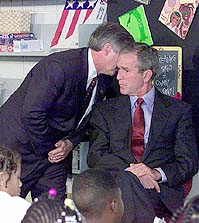The Pet Goat facts for kids
Quick facts for kids "The Pet Goat" |
|
|---|---|
| Author | Siegfried "Zig" Engelmann |
| Genre(s) | Educational |
"The Pet Goat" is a short reading exercise for young students. It was written by an American teacher named Siegfried Engelmann. This story became very well known because George W. Bush, who was the president of the United States at the time, was reading it with a class of second-graders on the morning of September 11, 2001. During the reading, President Bush was quietly told about the terrible events of the September 11 attacks. He waited for the reading to finish before he began to deal with the national crisis. This moment is often talked about when people look back at how President Bush reacted to the attacks.
Contents
The Pet Goat Reading Story
"The Pet Goat" was created by Siegfried Engelmann, also known as "Zig." He wrote many teaching exercises like this one since the 1970s. This story was part of a classroom workbook called Reading Mastery: Rainbow Edition, Level 2, Storybook 1.
Learning with "The Pet Goat"
The main goal of "The Pet Goat" is to help students learn words that end with the letter E. It uses a teaching method called Direct Instruction (DI). This method helps students learn step-by-step.
The story is about a girl and her pet goat. The goat eats everything, which makes the girl's parents want to get rid of it. But then, the goat helps stop a robbery by bumping into an intruder. The intruder becomes "sore" (a word ending in e). Because the goat saved the day, the parents decide to let it stay.
President Bush and the September 11 Attacks
On September 11, 2001, George W. Bush visited Emma E. Booker Elementary School in Sarasota, Florida. He was there to talk about his plans for education reform. When he arrived, he was told that a plane had crashed into One World Trade Center. At first, he was told it was probably just a small plane.
President Bush then sat in Kay Daniels' classroom. The students were reading "The Pet Goat." Suddenly, White House Chief of Staff Andrew Card walked over to the president. He whispered in Bush's ear: "A second plane hit the second tower. America is under attack."
Bush's Reaction in the Classroom
After hearing the news, the children kept reading. President Bush stayed seated, trying to remain calm. Even though he tried to hide his feelings, the students noticed something was wrong. They later said that the president's face turned red and serious. They described his expression as "shocked" and "horrified."
President Bush's press secretary, Ari Fleischer, gave him a note that said, "DON'T SAY ANYTHING YET." President Bush, who was usually very punctual, stayed in the classroom even after the reading finished. He did not want to show any panic. After talking briefly with the students and their teacher, he avoided a reporter's question about the World Trade Center. Then, he left to learn more about the serious attacks.
Public attention to "The Pet Goat" grew after a 2004 documentary called Fahrenheit 9/11. However, the film incorrectly called it "My Pet Goat." Later, a blogger found the correct name and explained that it was a reading exercise by Engelmann.
Why Bush Stayed Calm
Many people discussed President Bush's actions in the classroom. Some felt he should have reacted faster. However, his supporters argued that he needed more information. They also believed it was important not to scare the children.
President Bush later explained his actions. He said his goal was to "project calm" and not show an "excited reaction" during a crisis. He saw reporters behind the children, and their phones were ringing. He felt he needed to show strength and calm until he understood what was happening.
The principal of Booker Elementary, Tose-Rigell, supported President Bush. She said, "I don't think anyone could have handled it better. What would it have served if [Bush] had jumped out of his chair and ran out of the room?" The students also agreed that his actions were the right ones.
A year after the attacks, the chair where President Bush sat in Kay Daniels' classroom still had a purple ribbon on it. By 2004, Siegfried Engelmann, the author, was surprised by how much attention "The Pet Goat" had received. He said, "It hasn't brought me any fame, […] It's fascinating that anyone would even be interested in something like this."


